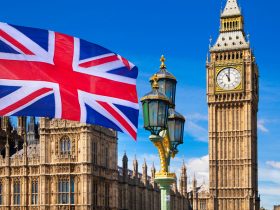The Great North Air Ambulance Service (GNAAS) may well be about to experience a flood of new applications from paramedics keen to join its ranks. The service now has a pretty enticing USP over other British Air Ambulance teams – you might get to fly a jetpack at work.
Three paramedics from the GNAAS are currently undergoing training provided by Richard Browning, the former Royal Marines reservist and BP oil trader behind jetsuit company Gravity Industries. The training is ahead of summer trials planned for the Lake District this year that will see paramedics fly up to casualties in jetsuits to administer assessment and care ahead of a helicopter or ground team’s arrival.
The Daedalus Flight Pack developed by Gravity Industries, which was founded by Browning in partnership with Red Bull and the magazine WIRED in 2017, packs 1050 horsepower. It has one large engine worn on the pilot’s back and another two smaller engines on each arm which are used to control direction.
In the most recent trial of the jetsuit, Browning is also the company’s chief test pilot, the Gravity Industries co-founder flew up to a point on Scafell Pike, England’s highest mountain. The journey was made in just 4 minutes at speeds of up to 40mph while it took a ground team 45 minutes to hike up to the same place.
Of the three paramedics currently being trained by Browning on safe use of the jetsuits, GNAAS director of operations Andy Mawson has become the first to fly freely with it without being tethered by a safety rope. He did so after five days of training and has another few weeks to complete before he’ll be allowed to take on call-outs carrying an additional 15kg of medical kit.
He comments:
“It’s been an incredible journey. The raw power of it when you first feel the thrust and the energy is amazing, but [Browning] has really good tried-and-tested ways to get people comfortable with it.”
“We think the jet-suit paramedic will speed up the response to some hard-to-access patients in the Lake District. But to know for sure we are putting it to the test.”
When Browning first started to develop his jetsuit it was seen as a piece of recreational technology and he would be invited to show it off at parties put on by wealthy clients as well as running experience days for people to try it out. However, while jetsuit flying is expected to become a popular extreme sport, its more practical applications of the technology that are now gathering most attention.
One is use by paramedics and other emergency services professionals on rough and remote terrain and the British Royal Navy has also run trials, demonstrating how the jetpacks could be used to board a ship. The technology could potentially be used by the Royal Navy to board modern-day pirate ships holding hostages and in other military scenarios.
Progress in developing the technology for mountain rescue teams was delayed by the 2020 onset of the pandemic and a lack of funding. However, Orsted, the Danish company that is the world’s largest offshore wind farm operator, has stepped up to fund the Lake District trials. Orsted hopes the paramedic trials will offer proof of concept the jetsuits could also be used to quickly reach offshore wind farms in an emergency.
Browning explains their involvement with:
“They want to accelerate this technology in the paramedic world and use that as a springboard for their own work. No one has ever done this before.”
Orsted’s head of operations innovation Peter Teglman Schioler added:
“With safety at the forefront of everything we do, we want to explore ways of getting emergency help to our colleagues in times of need.”
The cost of training a jetsuit pilot comes in at around £6500 a day, says Browning, and Orsted’s sponsorship has meant his company being able to put more time and resources into training the GNAAS team than would have otherwise been practically possible.
The Gravity Industries team will also oversee the trials and look at logistics such as the most efficient way to have the jetsuits on standby. They can be flown in winds of up to 35mph and poor visibility – the kind of conditions that would rule out the use of a rescue helicopter.
The suits, which cost £340,000 each, are seen as likely to be used during peak summer periods when time-sensitive cases like heart attacks are most likely. The GNAAS estimates they could be used in 15 to 20 callouts a week.









